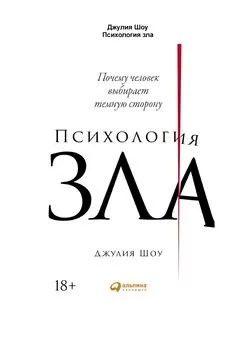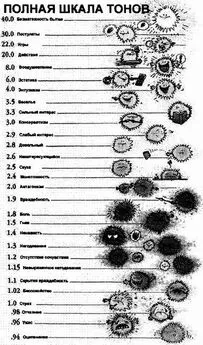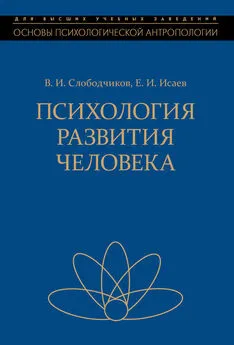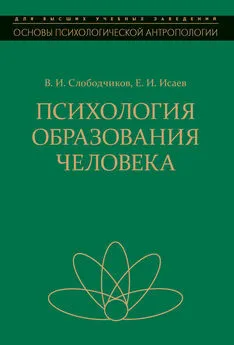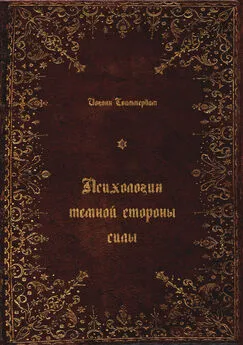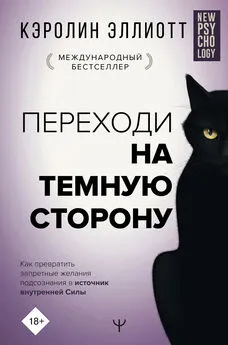Джулия Шоу - Психология зла. Почему человек выбирает темную сторону
- Название:Психология зла. Почему человек выбирает темную сторону
- Автор:
- Жанр:
- Издательство:Альпина Паблишер
- Год:2020
- Город:Москва
- ISBN:978-5-9614-3544-3
- Рейтинг:
- Избранное:Добавить в избранное
-
Отзывы:
-
Ваша оценка:
Джулия Шоу - Психология зла. Почему человек выбирает темную сторону краткое содержание
«Психология зла» - это подробное и увлекательное исследование темной стороны человека. Доктор Джулия Шоу на примерах из массовой культуры и реальной жизни предлагает порассуждать о проблемах, о которых обычно молчат, хотя знание факторов, способных спровоцировать недопустимое поведение, помогает замечать их и не давать им развернуться в полную силу.
Психология зла. Почему человек выбирает темную сторону - читать онлайн бесплатно ознакомительный отрывок
Интервал:
Закладка:
185
McPhail, I. V., Hermann, C. A., Fernane, S., Fernandez, Y M., . . . & Cantor, J. M. ‘Validity of phallometric tests for sexual interests in children: a meta-analytic review’. Assessment (2017), pp. 1-17.
186
Birrell, I. ‘Horror of senior detective’, Daily Mail, 21 June 2015; http://www.dailymail.co.uk/news/article-3132896/Horror-senior-detective-discovering-1-35-men-sexually-attracted-children.html.
187
Birrell, ‘Horror of senior detective’.
188
Stephenson, W. ‘How many men are paedophiles?’, BBC News, 30 July 2014; http://www.bbc.co.uk/news/magazine-28526106.
189
Stoltenborgh, M., Van Ijzendoorn, M. H., Euser, E. M., & Bakermans-Kranenburg, M. J. ‘A global perspective on child sexual abuse: meta-analysis of prevalence around the world’. Child Maltreatment, 16 (2) (2011), pp. 79-101.
190
McLeod, D. A. ‘Female offenders in child sexual abuse cases: a national picture’. Journal of Child Sexual Abuse, 24 (1) (2015), pp. 97-114.
191
Bailey et al. ‘An internet study’.
192
Evans, M., ‘One in 35 men has paedophile tendencies’, Daily Telegraph, 22 June 2015; http:// www.telegraph.co.uk/news/uknews/11690451/One-in-35-men-has-paedophile-tendencies-crime-agency-claims.html.
193
Cantor, J. M., & McPhail, I. V. ‘Non-offending pedophiles’. Current Sexual Health Reports, 8 (3) (2016), pp. 121-28.
194
Richards, K. ‘Misperceptions about child sex offenders’. Trends and Issues in Crime and Criminal Justice, 429 (2011), p. 1.
195
Langstrom, N., Enebrink, P., Lauren, E. M., Lindblom, J., . . . & Hanson, R. K. ‘Preventing sexual abusers of children from reoffending: systematic review of medical and psychological interventions’. British Medical Journal, 347 (2013), f4630.
196
Stoltenborgh et al. ‘A global perspective’.
197
Radford, L., Corral, S., Bradley, C., Fisher, H., . . . & Collishaw, S. ‘Child abuse and neglect in the UK today: research into the prevalence of child maltreatment in the United Kingdom’. NSPCC (2011).
198
Glasser, M., Kolvin, I., Campbell, D., Glasser, A., . . . & Farrelly, S. ‘Cycle of child sexual abuse: links between being a victim and becoming a perpetrator’. British Journal of Psychiatry, 179 (6) (2001), pp. 482-94.
199
Widom, C. S., & Massey, C. ‘A prospective examination of whether childhood sexual abuse predicts subsequent sexual offending’. JAMA Pediatrics, 169 (1) (2015); https://doi.org/10.1001/jamapediatrics.2014.3357; and Lee, J. K., Jackson, H. J., Pattison, P., & Ward, T. ‘Developmental risk factors for sexual offending’. Child Abuse & Neglect, 26 (1) (2002), pp. 73-92.
200
Babchishin, K. M., Hanson, R. K., & VanZuylen, H. ‘Online child pornography offenders are different: a meta-analysis of the characteristics of online and offline sex offenders against children’. Archives of Sexual Behavior, 44 (1) (2015), pp. 45-66.
201
Seto, M. C., Cantor, J. M., & Blanchard, R. ‘Child pornography offenses are a valid diagnostic indicator of pedophilia’. Journal of Abnormal Psychology, 115 (3) (2006), p. 610.
202
Cantor, J. M. ‘Gold star pedophiles in general sex therapy practice’. Principles and Practice of Sex Therapy (2014), pp. 219-34.
203
‘Are paedophiles’ brains wired differently?’ BBC News, 24 November 2015; http://www.bbc.co.uk/news/magazine-34858350.
204
Cantor, J. M., Kuban, M. E., Blak, T., Klassen, P E., . . . & Blanchard, R. ‘Physical height in pedophilic and hebephilic sexual offenders’. Sexual Abuse: A Journal of Research and Treatment, 19 (4) (2007), pp. 395-407.
205
Cantor, J. M., Klassen, P E., Dickey, R., Christensen, B. K., . . . & Blanchard, R. ‘Handedness in pedophilia and hebephilia’. Archives of Sexual Behavior, 34 (4) (2005), pp. 447-59.
206
Blanchard, R., Kolla, N. J., Cantor, J. M., Klassen, P E., . . . & Blak, T. ‘IQ, handedness, and pedophilia in adult male patients stratified by referral source’. Sexual Abuse: A Journal of Research and Treatment, 19 (3) (2007), pp. 285-309.
207
Cantor, J. M., Lafaille, S. J., Hannah, J., Kucyi, A., . . . & Mikulis, D. J. ‘Independent component analysis of resting-state functional magnetic resonance imaging in pedophiles’. The Journal of Sexual Medicine, 13 (10) (2016), pp. 1546-54.
208
Cantor et al. ‘Independent component’.
209
Joyal, C. C., Beaulieu-Plante, J., & de Chanterac, A. ‘The neuropsychology of sex offenders: a meta-analysis’. Sexual Abuse, 26 (2) (2014), pp. 149-77.
210
Seto, M. C. Pedophilia and Sexual Offending Against Children: Theory, Assessment, and Intervention. New York: American Psychological Association, 2007.
211
Cantor, J. M., Lafaille, S., Soh, D. W., Moayedi, M., . . . & Girard, T. A. ‘Diffusion tensor imaging of pedophilia’. Archives of Sexual Behavior, 44 (8) (2015), pp. 2161-72.
212
Houtepen, J. A., Sijtsema, J. J., & Bogaerts, S. ‘Being sexually attracted to minors: sexual development, coping with forbidden feelings, and relieving sexual arousal in self-identified pedophiles’. Journal of Sex and Marital Therapy, 42 (1) (2016), pp. 48-69.
213
McGuinness, D. ‘Germany urges paedophiles out of the shadows’. BBC News, 13 July 2015; http://www.bbc.co.uk/news/magazine-33464970.
214
Troup Buchanan, R., ‘In Germany, they treat paedophiles as victims’. Independent, 14 July 2015; http://www.independent.co.uk/news/world/in-germany-they-treat-paedophiles-as-victims-not-offenders-10387468.html.
215
McGuinness. ‘Germany urges paedophiles’.
216
McMillan, J. ‘The kindest cut? Surgical castration, sex offenders and coercive offers’. Journal of Medical Ethics, 40 (9) (2014), pp. 583-90.
217
Grubin, D., & Beech, A. ‘Chemical castration for sex offenders’. British Medical Journal, 304 (2010); https://doi.org/10.1136/bmj.c74.
218
McMillan. ‘The kindest cut?’
219
Lee, J. Y., & Cho, K. S. ‘Chemical castration for sexual offenders: physicians’ views’. Journal of Korean Medical Science, 28 (2) (2013), pp. 171-72.
220
Lewis, A., Grubin, D., Ross, C. C., & Das, M. ‘Gonadotrophin-releasing hormone agonist treatment for sexual offenders: a systematic review’. Journal of Psychopharmacology (2017); https://doi.org/10.1177/0269881117714048.
221
Berlin, F. S. ‘“Chemical castration” for sex offenders’. New England Journal of Medicine, 336 (14) (1997), pp. 1030-31.
222
‘Brian Hopkins, smuggler of child sex doll’. BBC News, 1 September 2017; http://www.bbc.co.uk/news/uk-england-devon-41130328.
223
‘Strategic Plan: 2013-2017’, Compassion in World Farming; https://www.ciwf.org.uk/media/3640540/ciwf_strategic_plan_20132017.pdf.
224
Murphy, H. ‘Fish depression is not a joke’. The New York Times, 16 October 2017; https://www.nytimes.com/2017/10/16/science/depressed-fish.html.
225
Bastian, B., & Loughnan, S. ‘Resolving the meat-paradox: a motivational account of morally troublesome behavior and its maintenance’. Personality and Social Psychology Review 21 (3) (2017), pp. 1-22; https://doi.org/10.1177/1088868316647562.
226
Festinger, L. A Theory of Cognitive Dissonance. Evanston, IL: Row, Peterson & Co., 1957.
227
Festinger, L., & Carlsmith, J. M. ‘Cognitive consequences of forced compliance’. Journal of Abnormal and Social Psychology, 58 (2) (1959), p. 203.
228
Фестингер Л. Теория когнитивного диссонанса. — СПб.: Речь, 2000.
229
Grauerholz, L. ‘Cute enough to eat: the transformation of animals into meat for human consumption in commercialised images’. Humanity & Society, 31 (4) (2007), pp. 334-54.
230
Bastian & Loughnan. ‘Resolving the meat-paradox’, pp. 278-99.
231
Fiske, A. P., & Tetlock, P E. ‘Taboo trade-offs: reactions to transactions that transgress the spheres ofjustice’. Political Psychology, 18 (2) (1997), pp. 255-97.
232
Tetlock, P E., Kristel, O. V., Elson, S. B., Green, M. C., & Lerner, J. S. ‘The psychology of the unthinkable: taboo trade-offs, forbidden base rates, and heretical counterfactuals’. Journal of Personality and Social Psychology, 78 (5) (2000), p. 853.
233
Tetlock, P E. ‘Thinking the unthinkable: sacred values and taboo cognitions’. Trends in Cognitive Sciences, 7 (7) (2003), pp. 320-24.
234
Judicial College. Guidelines for the Assessment of General Damages in Personal Injury Cases. Oxford: OUP, 2017. В эту сумму не входит компенсация за потерю заработка, стоимость соответствующего медицинского обслуживания и прочие расходы.
235
Kahneman, D., Schkade, D., & Sunstein, C. ‘Shared outrage and erratic awards: the psychology of punitive damages’. Journal of Risk and Uncertainty, 16 (1) (1998), pp. 49-86.
236
Bales, K. Ending Slavery: How We Free Today’s Slaves. Berkeley: University of California Press, 2007.
237
Bales, K. ‘How to combat modern slavery’. TED Talk, February 2010; https://www.ted.com/talks/kevin_bales_how_to_combat_modern_slavery.
238
Baumeister, R. F. Evil: Inside Human Cruelty and Violence. New York: W. H. Freeman, 1997.
239
Lucas, T., Zhdanova, L., & Alexander, S. ‘Procedural and distributive justice beliefs for self and others’. Journal of Individual Differences, 32 (1), (2011).
240
Lucas, T., Zhdanova, L., Wendorf, C. A., & Alexander, S. ‘Procedural and distributive justice beliefs for self and others: multilevel associations with life satisfaction and self-rated health’. Journal of Happiness Studies, 14 (4) (2013), pp. 1325-41.
241
Lerner, M. J., & Simmons, C. H. ‘Observer’s reaction to the “innocent victim”: compassion or rejection?’ Journal of Personality and Social Psychology, 4 (2) (1966), p. 203.
242
Hafer, C. L., & Sutton, R. ‘Belief in a just world’. In: Handbook of Social Justice Theory and Research. Clara Sabbagh & Manfred Schmitt (eds). New York: Springer, 2016, pp. 145-60.
243
Интервал:
Закладка:
